
Coins of Sogdiana with images and descriptions
History of Sogdiana
Sogdiana is an ancient region of Central Asia, located in the basin of rivers Zaravshan and Kashkadarya (in modern territory of Uzbekistan and partially Tajikistan). Sogdians are one of the most ancient people of Central Asia. Their images are known from the Achaemenids reliefs. Sogdians played a large role in the Achaemenid state, along with Bactrians, Khwarezmians, Parthians, Margians and other peoples of Central Asia they comprised a large part of the Persian army.
Sogdiana and Parthia comprised the XVII satrapy of Achaemenid Iran. Sogdians had borrowed their written language from Iran; out of post-Achaemenid clerical Aramaic writing had emerged four ideographic writing systems: Parthian, Persian, Sogdian and Khwarezmian. These writing systems had endured in Central Asia and Iran for many centuries, until these states were conquered by the Arabs.
During the Achaemenid period, the peoples of Central Asia, Sogdiana in particular, for the first time had been introduced to minted coins. Examples of gold darics and other coins of the Achaemenid monetary system have been found on the territory of Central Asia as well. During the short period of Hellenistic domination Sogdians had been introduced to coins of Greek type. After the Seleukids had lost control over this region, their mass flow had seized, and the local rulers had organized their own coinage.
However, the level of development in Sogdian society was not high enough to realize to the end either the true “economic” value, or the proclamatory potential of coins. As a result, local issues had acquired imitative character: the most popular in the marketplace Greek coins were copied. Further, each following generation of imitations as a rule would copy the previous type. With the passage of time, errors and deviations from the original prototype would accumulate, images would get cruder and lose their meaning, and inscriptions would get illegible, would ornament or would disappear altogether.
Judging from the topography of coin finds in Sogdiana, there were at least three independent principalities in the last centuries B.C.: Samarkand rulers (Eastern Sogdiana) struck imitations of coins of Antiochus I, Bukharian rulers (Western Sogdiana) based their mintage on tetradrachms of the Graeco-Bactrian king Euthydemus, and at the same time began minting two types of coins with the name of Hirkodes. On obverse of each type is the head of the ruler right, on reverse forequarter of a horse or a standing solar deity with flames at the shoulders. And in the Kashkadarya valley (Southern Sogdiana) they imitated drachms of the Seleukids portraying Alexander the Great.
During the early Middle Ages Sogdiana had become the main intermediary in the world trade between East and West. Profits from it had become a foundation for fast growth of cities, which started at the end of the IV century A.D. Crafts and internal trade were developing. When in the V century the establishment of an independent monetary system had just begun, already in the VII century it had become well developed and adopted to all spheres of trade.
On early Sogdian coins, on obverse and image of a goddess with straight hair is also encountered. But starting from the middle of VII century, Rulers of Sogdiana, Ishkhids, and the masters of subordibate to them domains had started issuing cast coins with a square opening, devoid of any images of rulers or deities. On obverse, a Sogdian inscription in italics is placed, with name and title, and on reverse – a dynastic symbol, for each ruler his own. Sogdiana had never existed as a single state, but consisted of a conglomerate of principalities and free cities, possibly united into a confederation under the supremacy of the strongest sovereign.
At least Sogdiana was a part of the empire of the Hephtalites, and after 563 a part of the Turkic kaganate. After 630 AD the Sogdian confederation had become independent, although nominally it recognized the sovereignty of China, which routed the Turks. And finally, beginning with the first half of the 7th century, Sogdiana, as well as the rest of Central Asia, had finally become a part of the Arabic khaliphate.
Coins catalog of Sogdiana
Western Sogd
Imitation of the Euthydemus tetradrachm
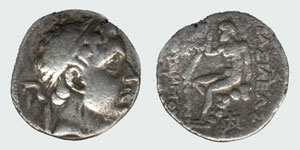
WS 1. Imitation of the tetradrachm of the Greco-Bactrian king Euthydemus.
II century BC – I century
AD Obverse: Head of the ruler in a diadem to the right. Reverse: Hercules seated on an omphale, Greek legend in two lines: BASILEWS
EYQYDHMOY.
There is a monogram underneath. Silver.
D-25 mm.
Weight 11.7 grams.
/Rare/
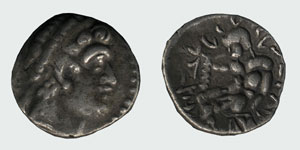
WS 2. Imitation of the tetradrachm of the Greco-Bactrian king Euthydemus.
First half of the 1st century
AD Obverse: Head of the ruler in a diadem to the right. Reverse: Hercules seated on an omphalos, surrounded by a Sogdian legend. Silver.
D-24 mm.
Weight 9.3 grams.
/ Very Rare /
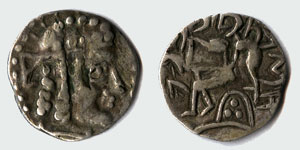
WS 3. Imitation of the tetradrachm of the Greco-Bactrian king Euthydemus.
Second half of the 1st century.
AD Obverse: Head of a local ruler in a diadem to the right. Reverse: Schematic image of a seated Hercules, surrounded by a Sogdian legend. (#24 Culture and art of ancient Uzbekistan. vol. #1. #240.) Silver.
D-25 mm.
Weight 9.2 grams.
/ Very Rare /
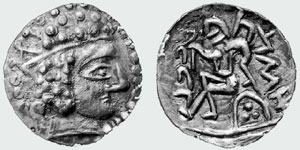
WS 4. Imitation of the tetradrachm of the Greco-Bactrian king Euthydemus.
III century
AD Obverse: Head of a local ruler in a tiara to the right. Reverse: Schematic image of a seated Hercules, surrounded by a Sogdian legend. (#24 Culture and art of ancient Uzbekistan. vol. #1. #241.) Silver.
D-26 mm.
Weight 8.4 grams.
/ Extremely Rare /
Girkoda
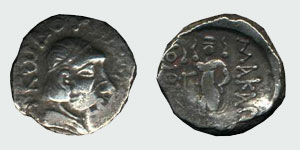
WS 5. Coin “Girkoda”.
I century
BC. Obverse: Bust-length image of the ruler’s head to the right.
Behind the head is a Greek legend: YPKwDoY.
Reverse: Standing deity.
There is a spear in the right hand, flames fluttering on the shoulders.
Greek legend on both sides. Silver.
D-14 mm.
Weight 4 grams.
/ Very Rare /
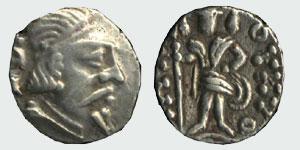
WS 6. Coin “Girkoda”.
I – II centuries
AD Obverse: Bust-length image of the ruler’s head to the right.
Behind the head is a distorted Greek legend. Reverse: Standing deity.
There is a spear in the right hand, flames fluttering on the shoulders.
A distorted Greek legend on both sides. Silver.
D-14 mm.
Weight 1.3 grams.
/Rare/
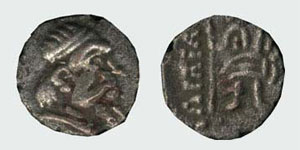
WS 7. Coin “Girkoda”.
III – IV centuries.
AD Obverse: Bust-length image of the ruler’s head to the right. Reverse: Schematic representation of a standing deity, a distorted Greek legend. Silver.
D-12 mm.
Weight 0.6 grams.
/ Scarse /
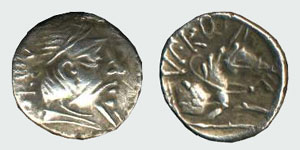
WS 9. Coin “Hirkoda”.
I century
AD Obverse: Bust-length image of the ruler’s head to the right.
Behind the head is the Greek legend YPKwDoY. Reverse: Protoma of a horse to the right, followed by the Greek legend YPKwDoY
. Silver.
D-15 mm.
Weight 1.6 grams.
/Rare/
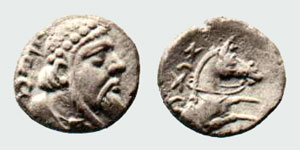
WS 10. Coin “Hirkoda”.
III century
AD Obverse: Image of the ruler’s head to the right.
Behind the head is a Sogdian legend. Reverse: Prothoma of a horse to the right, followed by a Sogdian legend. Silver.
/ Extremely Rare /

WS 11. Coin “Hirkoda”.
II – III centuries
AD Obverse: Image of the ruler’s head to the right. Reverse: Prothoma of a horse to the left. Silver.
D-11 mm.
Weight 0.4 grams.
/Rare/
Mavac

WS 12. Ruler Mavac.
Beginning of the 5th century. Obverse: Bust image of the ruler to the right.
The hair is caught up in a tiara, and there is a decoration in the form of a pectoral on the neck. Reverse: In the center of the coin there is a fire altar, around is a Sogdian legend written in Bukhara semi-cursive writing. (# 32 N.Ts.A. #1./ A. Naimark, About the beginning of the minting of copper coins in Bukhara Sogd. p. 40, # 1.) Silver.
D-12 mm.
Weight 0.7 grams.
/ Extremely Rare /
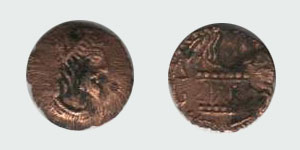
WS 13. Ruler Mavac.
Beginning of the 5th century. Obverse: Bust image of the ruler to the right.
The hair is caught up in a tiara, and there is a decoration in the form of a pectoral on the neck. Reverse: In the center of the coin there is a fire altar, around is a Sogdian legend written in Bukhara semi-cursive writing. (# 32 N.Ts.A. #1./ A. Naimark, About the beginning of the minting of copper coins in Bukhara Sogd. p. 40, # 14.) Copper.
D-11 mm.
Weight 0.4 grams.
/ Extremely Rare /
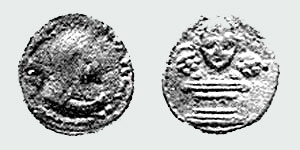
WS 14. Ruler Mavac.
Beginning of the 5th century. Obverse: Bust image of the ruler to the right. Reverse: In the center of the coin is a fire altar with the head of Ahura Mazda. (# 32 N.Ts.A. #1./ A. Naimark, On the beginning of the minting of copper coins in Bukhara Sogd. p. 43, # 1.) Copper.
/ Extremely Rare /
Asbar
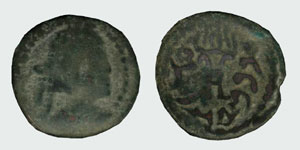
WS 16. Ruler Asbar.
From the middle of the 5th to the middle of the 6th centuries. Obverse: Bust-length image of the ruler to the right. Reverse: In the center of the coin there is a stylized altar of fire, in the form of a Bukhara tamga sign with flames.
Around the Sogdian legend “Sovereign Asbar”. ( # 36 E.V. Rtveladze, Ancient coins…, p. 38) Copper.
D-15 mm.
Weight 1.8 grams.
/Common/
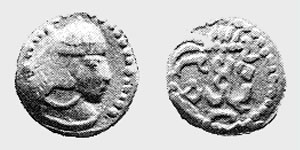
WS 17. Imitation of Asbara coins.
Second half of the 5th to the middle of the 6th centuries. Obverse: Bust image of the ruler to the right. Reverse: In the center of the coin there is a stylized altar of fire, in the form of a Bukhara tamga sign with flames.
Around is a stylized Sogdian legend. (#53 E. Zeimal’, Circulation…, p.250, #8.) Copper.
/ Scarce /

WS 18. Imitation of Asbara coins.
Second half of the 5th to the middle of the 6th centuries. Obverse: Bust-length image of a bearded ruler wearing a radial crown to the right. Reverse: In the center of the coin there is a stylized altar of fire, in the form of a Bukhara tamga sign with flames.
Around is a stylized Sogdian legend. Copper.
D-15 mm.
Weight 1.6 grams.
/Rare/
Unknown ruler
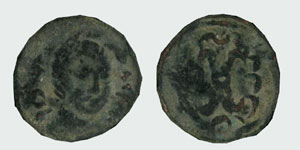
WS 19. Unknown ruler.
Second half of the 6th century. Obverse: Image of the ruler’s head three-quarters to the right. Reverse: In the center of the coin there is a Bukhara tamga sign, on the sides there is a Sogdian legend. (#53 E. Zeimal’, Circulation…, p.250, #10.) Copper.
D-17 mm.
Weight 1.7 grams.
/Rare/
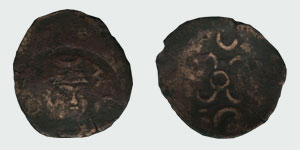
WS 20. Unknown ruler.
Second half of the 6th century. Obverse: Image of the ruler’s head in a headdress crowned with a crescent, three-quarters to the right. Reverse: In the center of the coin there is a Bukhara tamga sign, on the sides there is a Sogdian legend. (#53 E. Zeimal’, Circulation…, p.250, #11.) Bronze.
D-19 mm.
Weight 1.4 grams.
/ Very Rare /
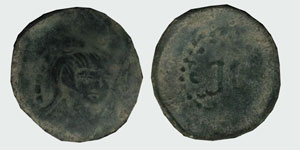
WS 21. Unknown ruler.
Second half of the 6th century. Obverse: Image of the ruler’s head three-quarters to the right. Reverse: In the center of the coin is the Bukhara tamga sign, around is the Sogdian legend. Bronze.
D-26 mm.
Weight 1.9 grams.
/ Extremely Rare /
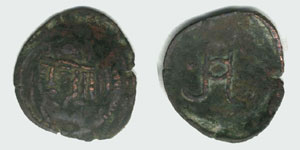
WS 22. Unknown ruler.
Second half of the 6th century. Obverse: Image of the head of the ruler (ruler) three-quarters to the left. Reverse: In the center of the coin is the Bukhara tamga sign. Bronze.
D-20 mm.
Weight 1.1 grams.
/ Extremely Rare /
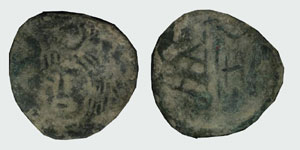
WS 23. Unknown ruler.
Second half of the 6th century. Obverse: Image of the ruler’s head in a headdress crowned with a crescent, three-quarters to the left. Reverse: In the field of the coin there is a Bukhara tamga sign. Bronze.
D-16 mm.
Weight 1.2 grams.
/ Extremely Rare /
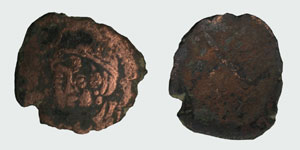
WS 24. Unknown ruler.
Second half of the 6th century. Obverse: Image of the ruler’s head three-quarters to the left. Reverse: (In the field of the coin there is a Bukhara tamga sign.) Copper.
D-15 mm.
Weight 1.5 grams.
/ Extremely Rare /
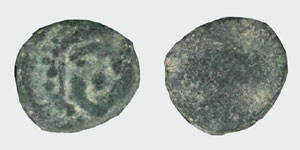
WS 25. Unknown ruler.
Second half of the 6th century. Obverse: Image of the ruler’s head three-quarters to the left. Reverse: Smooth, no differences.
There are coins of this type with an image of a fire altar on the reverse. Bronze.
D-10 mm.
Weight 0.9 grams.
/ Scarce /
Gatfar
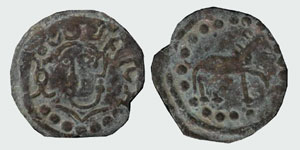
WS 26. Ruler Gatfar – leader of the Hephthalites.
Second half of the 6th century. Obverse: Image of the ruler’s head in a tiara, three-quarters to the left.
To the right of the portrait is the Sogdian legend, to the left is the Bukhara tamga sign. Reverse: Image of a horse to the right. This type of coin has a variety with a ruler three-quarters to the right on the obverse. Bronze.
D-18 mm.
Weight 1.1 grams.
/ Extremely Rare / (#55. E. Rtveladze. Gatfar’s washes…)
Unknown ruler
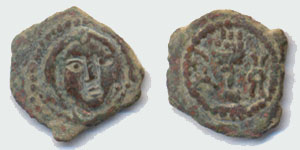
WS 27. Unknown ruler.
Second half of the 6th century. Obverse: Image of the ruler’s head three-quarters to the right. Reverse: In the center of the coin is an altar of fire.
To the right of it is the Bukhara tamga sign, to the left is the Sogdian legend. (#53 E. Zeimal’, Circulation…, p.250, #12.) Bronze.
D-18 mm.
Weight 2 grams.
/Rare/
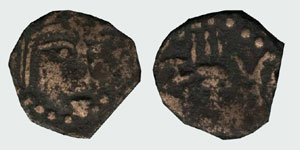
WS 28. Unknown ruler.
Second half of the 6th century. Obverse: Image of the ruler’s head three-quarters to the right. Reverse: In the center of the coin is a stylized image of a fire altar.
On either side of it are a stylized Bukhara tamga sign and a Sogdian legend. Bronze.
D-13 mm.
Weight 1.4 grams.
/Rare/
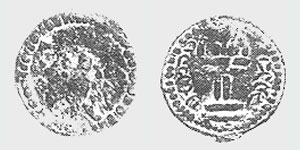
WS 29. Unknown ruler.
First half of the 7th century. Obverse: Image of a Bactrian camel facing right. Reverse: In the center of the coin there is a fire altar, on either side there is a Sogdian legend. (#53 E. Zeimal’, Circulation…, p.250, #18.) Bronze.
/ Extremely Rare /
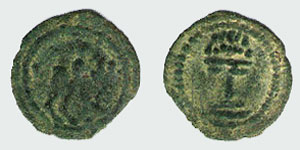
WS 30. Unknown ruler.
First half of the 7th century. Obverse: Image of a Bactrian camel facing right. Reverse: In the center of the coin is an altar of fire. (#53 E. Zeimal’, Circulation…, p.250, #19.) Bronze.
D-18 mm.
Weight 1.2 grams.
/Common/
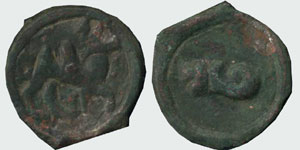
WS 31. Unknown ruler.
First half of the 7th century. Obverse: Image of a Bactrian camel facing right. Reverse: In the center of the coin is a one-word Sogdian legend. (#53 E. Zeimal’, Circulation…, p.250, #23.) Bronze.
D-18 mm.
Weight 1.3 grams.
/ Scarce /
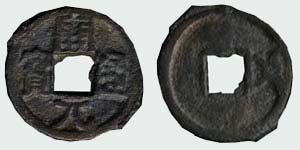
WS 33. Unknown ruler.
640-708 Obverse: On the sides of the square hole there are four characters: Kai-yuan tong-bao. Reverse: In the coin field to the right of the square hole, Bukhara tamga sign. ( # 41 O.I. Smirnova, Union catalogue…, # 1379 ). Bronze.
D-24 mm.
Weight 3.2 grams.
/ Very Rare /
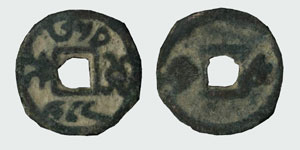
WS 34. Unknown ruler.
640-708 Obverse: To the right of the square hole is the Bukhara tamga sign, to the left is the Chinese hieroglyph “yuan”, above and below is a Sogdian legend. Reverse: To the right and left of the square hole are signs in the form of a cross. (#53 E. Zeimal’, Circulation…, p.250, #16.) Bronze.
D-18 mm.
Weight 1.2 grams.
/ Extremely Rare /
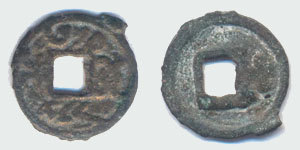
WS 34a. Unknown ruler.
640-708 Obverse: To the right of the square hole is the Bukhara tamga sign, to the left is the Chinese hieroglyph “yuan”, above and below is a Sogdian legend. Reverse: To the right of the square hole is a sign in the form of a cross. (#53 E. Zeimal’, Circulation…, p.250, #16.) Bronze.
/ Extremely Rare /

WS 35. Unknown ruler.
640-708 Obverse: To the right and left of the square hole is the Bukhara tamga sign.
Below is a sign in the form of a cross, above is a Sogdian legend. Reverse: Smooth, no differences. (#53 E. Zeimal’, Circulation…, p.250, #15.) Bronze.
D-18 mm.
Weight 1.3 grams.
/ Extremely Rare /
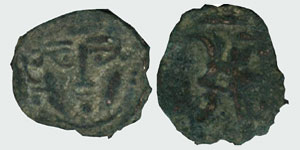
WS 36. Unknown ruler.
Not earlier than 709 – until the middle of the 8th century. Obverse: Image of the head of the ruler (ruler) in front. Reverse: In the center of the coin is the Bukhara tamga sign. Bronze.
D-17 mm.
Weight 1.8 grams.
/ Extremely Rare /
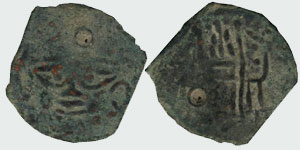
WS 37. Unknown ruler.
Not earlier than 709 – until the middle of the 8th century. Obverse: Image of the head of the ruler (ruler) in front. Reverse: Image of a stylized fire altar, flanked by a mobeda. Bronze.
D-16 mm.
Weight 1.2 grams.
/ Extremely Rare /
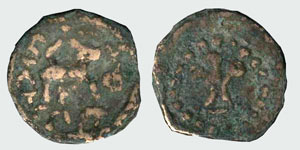
WS 41. Unknown ruler. Obverse: Image of a predator to the right.
Around is a Sogdian legend written in a separate unical Bukhara script. Reverse: In the center of the coin there is a tamga sign, surrounded by large dots. Bronze.
D-18 mm.
Weight 1.3 grams.
/ Extremely Rare /
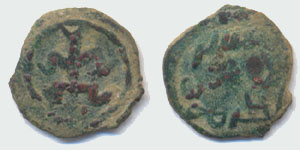
WS 42. Unknown ruler. Obverse: In the center of the coin is the tamga sign “Dancing Man”. Reverse: Arabic legend “60 in a dirham”. Bronze.
/ Extremely Rare /
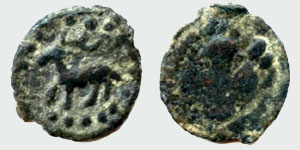
WS 43. Obverse: Image of an antlered deer to the left.
There is a dotted rim along the edge of the coin. Reverse: There is a cross in the center of the coin. Bronze. / Extremely Rare /
Paikend city
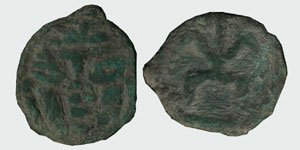
WS 38. City of Paikend.
Not earlier than 709 – until the middle of the 8th century. Obverse: Image of the head of the ruler (ruler) in front. Reverse: In the center of the coin is the tamga sign “Dancing Man”. Bronze.
D-17 mm.
Weight 1.4 grams.
/ Extremely Rare /

WS 39. City of Paikend.
Second quarter of the 8th century. Obverse: Three-line inscription in early Kufic script “Muhammad rassool Allah”. Reverse: In the center of the coin is the tamga sign “Dancing Man”. ( # 41 O.I. Smirnova, Union catalogue…, # 1671 ). Bronze.
D-14 mm.
Weight 1.4 grams.
/ Extremely Rare /
Vardanzi city
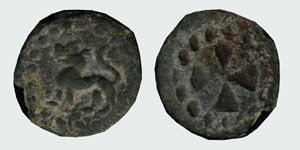
WS 40. City of Vardanzi (?) 625-675. Obverse: Image of a predator (lion) facing left, surrounded by large dots. Reverse: In the center of the coin there is a Nestorian cross. Bronze.
D-16 mm.
Weight 1.3 grams.
/ Extremely Rare /
Eastern Sogd
Imitation of Antiochus coin

ES 1. Imitation of Antiochus.
I-II century
BC. Obverse: Head of the ruler to the right. Reverse: Image of a horse’s protoma to the right.
Bottom right is the mint’s monogram. (#19 Zeimal E.V., Ancient coins…, table 9. #04). Silver.
D-16 mm.
Weight 2.2 grams.
/ Very Rare /
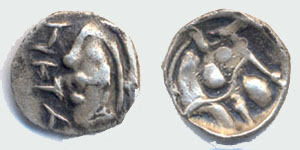
ES 38. Imitation of Antiochus.
II-IV centuries Obverse: Head of the ruler to the left.
Before her is a Sogdian legend. Reverse: Image of a horse’s protoma to the right. Unpublished. Silver. /Extremely Rare/
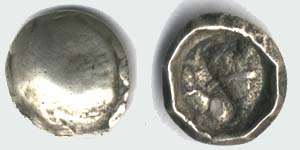
ES 2. Imitation of Antiochus.
II – IV centuries. Obverse: Remains of the image of the ruler’s head. Reverse: Image of a horse’s protoma to the right. Silver.
D-14 mm.
Weight 1.9 grams.
/ Very Rare / Subsequently, coins of this type decreased in size and weight, and at the last stages of issue, they began to be made from a copper alloy.
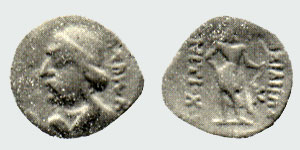
ES 3. I-II century.
AD Obverse: Head of the ruler to the left, followed by a distorted Greek legend. Reverse: Image of an archer to the right.
On both sides of it is a distorted Greek legend in two vertical lines. (#19 Zeimal E.V., Ancient coins…, table 31. #02). Silver.
/ Extremely Rare /
Unknown ruler
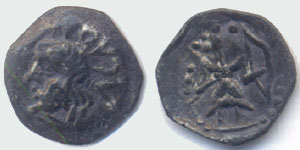
ES 4. Unknown ruler.
II-III century Obverse: Head of a bearded ruler to the left.
Above is a Sogdian legend. Reverse: In the center of the coin there is an image of an archer to the right, all in a dotted rim. (#19 Zeimal E.V., Ancient coins…, table 31. #08). Silver.
/ Very Rare /
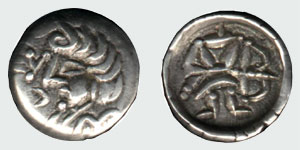
ES 5. Unknown ruler.
IV-V centuries Obverse: Stylized image of the ruler’s head to the left.
Before him is a Sogdian legend. Reverse: Stylized image of an archer to the right. (#19 Zeimal E.V., Ancient coins…, table 32. #53). Silver.
D-10 mm.
Weight 0.4 grams / Rare /
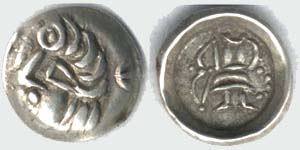
ES 5a. Unknown ruler.
IV-V centuries Obverse: Stylized image of the ruler’s head to the left.
Before him is a Sogdian legend. Reverse: Stylized image of an archer facing left. Unpublished Silver.
D-10 mm.
Weight 0.4 grams.
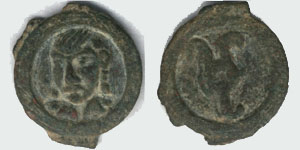
ES 6. Anepigraphic.
Unknown ruler of the 5th-6th centuries. Obverse: Image of the head of the ruler (ruler) three-quarters to the left.
There are large earrings in the ears. Reverse: In the center of the coin there is a tamga sign. ( # 41 O.I. Smirnova, Union catalogue…, # 1 ). Bronze.
D-23 mm.
Weight 3.4 grams.
/ Scarse /
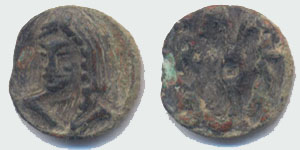
ES 7. Unknown ruler of the 6th century. Obverse: Image of the head of a ruler or deity, three-quarters to the left. Reverse: In the center of the coin there is a tamga sign, on the sides there is a Sogdian legend. ( # 41 O.I. Smirnova, Union catalogue…, # 26 ). (Bronze) / Rare /
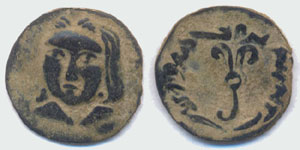
ES 8. Unknown ruler of the 6th century. Obverse: Image of the head of the ruler (ruler). Reverse: In the center of the coin there is a tamga sign, around is a Sogdian legend. ( # 41 O.I. Smirnova, Union catalogue…, # 33 ). Bronze.
D-25 mm.
Weight 2.6 grams.
/ Very Rare /
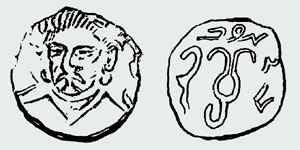
ES 9. Unknown ruler.
VI-VII centuries Obverse: Image of the head of a ruler with a lush mustache, three-quarters to the left. Reverse: In the center of the coin there is a tamga sign.
There is a Sogdian legend around. ( # 41 O.I. Smirnova, Union catalogue…, # 37 ). (Bronze) /Extremely Rare/
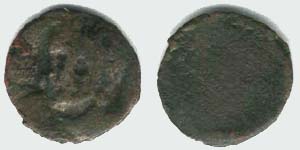
ES 10. Unknown ruler.
VI-VII centuries Obverse: Image of the head of a ruler with a lush mustache, three-quarters to the left. Reverse: Smooth without any differences. ( # 41 O.I. Smirnova, Union catalogue…, # 38 ). Bronze.
D-18 mm.
Weight 1.4 grams.
/Extremely Rare/
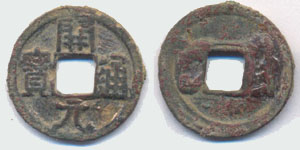
ES 11. Pseudo-Tan coin.
VII century Obverse: Four hieroglyphs arranged crosswise on the sides of a square hole.
Kai-yuan tong-bao – “Exchange coin (period) Kai-yuan” Reverse: To the left of the square hole is the Chinese key tao “knife”, stylized as the U-shaped sign-tamga of the Ishkhids of Sogd.
On the right is a Sogdian legend consisting of one word “God”. ( # 41 O.I. Smirnova, Union catalogue…, # 43 ). Bronze.
/ Very Rare /
Shishpir
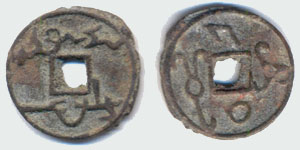
ES 12. Ruler Shishpir.
No later than 642 – no later than 655. Obverse: On the sides of the square hole there are four tamga signs, arranged crosswise. Reverse: Above and below the square hole is the Sogdian legend “Ishkhid Shishpir”. ( # 41 O.I. Smirnova, Union catalogue…, # 48 ). Bronze.
/Rare/
Vuzurg

ES 13. Ruler Vuzurg.
VII century Obverse: To the right and left of the square hole are tamga signs. Reverse: Above and below the square hole is the Sogdian legend “Ishkhid Vuzurg(?)”. ( # 41 O.I. Smirnova, Union catalogue…, # 78 ). Bronze.
/Rare/
Varhuman
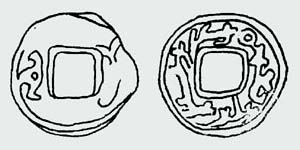
ES 14. Ruler Varhuman.
650/655 – no later than 696. Obverse: To the right and left of the square hole are tamga signs. Reverse: Around the square hole is the Sogdian legend “Mr. Varhuman, King”. ( # 41 O.I. Smirnova, Union catalogue…, # 102 ). (Bronze) /Extremely Rare/
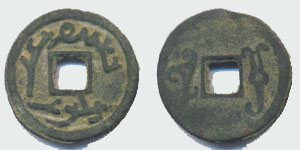
ES 15. Ruler Varhuman.
650/655 – no later than 696. Obverse: To the right and left of the square hole are tamga signs. Reverse: Around the square hole is the Sogdian legend “King Varhuman”. ( # 41 O.I. Smirnova, Union catalogue…, # 106 ). Bronze.
/Very Rare/
Mastan-Navian
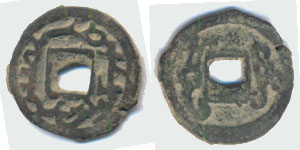
ES 16. Ruler of Mastan-Navian(?) 698-700(?) Obverse: To the right and left of the square hole are tamga signs. Reverse: Around the square hole is the Sogdian legend “ishkhid Mastan-?” ( # 41 O.I. Smirnova, Union catalogue…, # 168 ). Bronze.
/ Very Rare /
Tukaspadak
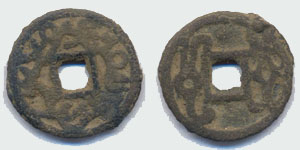
ES 17. Ruler Tukaspadak.
696-698 Obverse: To the right and left of the square hole are tamga signs. Reverse: Around the square hole is the Sogdian legend “ishkhid Tukaspadak”. ( # 41 O.I. Smirnova, Union catalogue…, # 191 ). Bronze.
/ Very Rare /
Tarhun
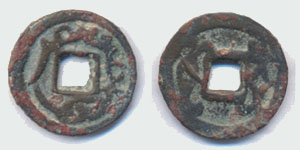
ES 18. Ruler Tarhun.
700(?)-710 Obverse: To the right and left of the square hole are tamga signs. Reverse: Legend in two concentric lines “ishkhid Tarhun”. ( # 41 O.I. Smirnova, Union catalogue…, # 215 ). Bronze.
/ Scarse /
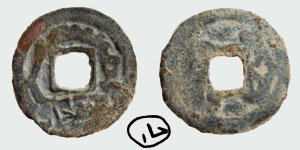
ES 18a. Ruler Tarhun.
700(?)-710 Obverse: To the right and left of the square hole are tamga signs. Reverse: Legend in two concentric lines “ishkhid Tarhun”. Bronze.
/ Extremely Rare /
Gurek
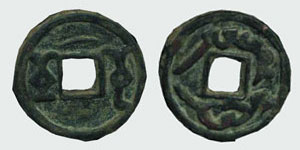
ES 19. Ruler Gurek.
710(?)-738 Obverse: To the right and left of the square hole are tamga signs. Reverse: Legend in two concentric lines “ishkhid Gurak (Urak)”. ( # 41 O.I. Smirnova, Union catalogue…, # 359 ). Bronze.
D-23 mm.
Weight 3.3 grams.
/ Scarce /
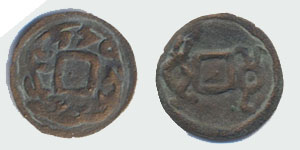
ES 20. Imitation of Gurek.
After 738. Obverse: In the center of the coin there is a frame imitating a square hole.
On either side of it there are tamga signs. Reverse: Legend in two concentric lines “ishkhid Gurek (Urak)” ( # 41 O.I. Smirnova, Union catalog…, # 400). Bronze.
/ Very Rare /
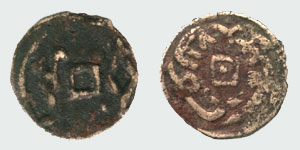
ES 21. Imitation of Gurek.
After 738. Obverse: In the center of the coin there is a frame imitating a square hole.
On either side of it there are tamga signs. Reverse: Legend in two concentric lines “ishkhid Gurek (Urak)” ( # 41 O.I. Smirnova, Union catalog…, # 336). Bronze.
D-21 mm.
Weight 1.7 grams.
/ Very Rare /
Turgar
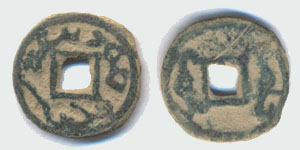
ES 22. Ruler Turgar.
738-750(?) Obverse: To the right and left of the square hole are tamga signs. Reverse: Around the square hole is the Sogdian legend “Ishkhid Turgar” (# 41 O.I. Smirnova, Union catalog…, #474). Bronze.
/Rare/
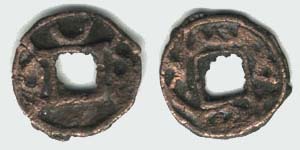
ES 23. Ruler Turgar.
738-750(?) Obverse: To the right and left of the square hole are tamga signs.
A sign has been added at the top. Reverse: Around the square hole is the Sogdian legend “Ishkhid Turgar” (# 41 O.I. Smirnova, Union catalog…, #519). Bronze.
18 mm.
/Common/
Urk-Vartamuk
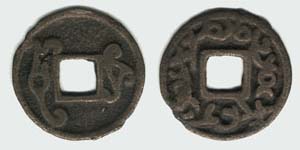
ES 24. Ruler of Urk-Vartamuk.
Beginning of the 8th century. Obverse: To the right and left of the square hole are tamga signs. Reverse: Around the square hole is the Sogdian legend “Ishkhid Urk-Vartamuk”. (#41 O.I.Smirnova, Union catalog…, #301). Bronze.
27 mm.
/Scarse/
Fansara
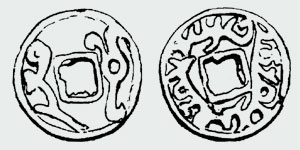
ES 25. With the name “Fansara”.
VIII century. Obverse: To the right of the square hole is a tamga sign, to the left is a Sogdian legend consisting of one word. Reverse: There is a Sogdian legend around the square hole. (#41 O.I.Smirnova, Union catalog…, #733). Bronze (24-25 mm.) /Extremely Rare/
Pargar
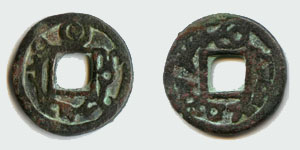
ES 26. With the name “Pargar”.
VIII century. Obverse: To the right of the square hole there is a tamga sign, on top there is a sign in the form of a crescent with a dot.
On the left and below, a Sogdian legend, each consisting of one word. Reverse: There is a Sogdian legend around the square hole. (#41 O.I.Smirnova, Union catalog…, #734). Bronze.
25 mm.
/Extremely Rare/
Pancha
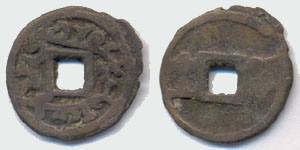
ES 27. Ruler Pancha Amukyan.
First half of the 8th century. Obverse: To the right and left of the square hole are tamga signs. Reverse: Around the square hole is the Sogdian legend “Ruler Pancha Amukyan”. (# 41 O.I. Smirnova, Union catalog…, #735). Bronze.
26 mm.
/Extremely Rare/
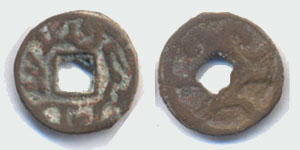
ES 28. Ruler of Pancha, Nana mistress.
The end of the 7th – beginning of the 8th century. Obverse: Tamga sign, inscribed in a square hole. Reverse: Around the square hole is the Sogdian legend “Pancha Nana Mistress”. (#41 O.I.Smirnova, Union catalog…, #769). Bronze.
/Very Rare/
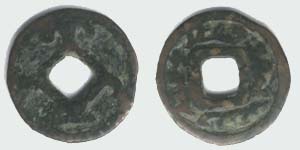
ES 29. Ruler of Pancha, Bidkan.
Late 7th – early 8th centuries. Obverse: In the field of the coin, the tamga sign frames a square hole. Reverse: Around the square hole is the Sogdian legend “Mr. Afshin Pancha Bidkan”. ( # 41 O.I. Smirnova, Union catalogue…, # 997 ). Bronze.
21 mm.
/ Very Rare /
Unknown Ishkhid
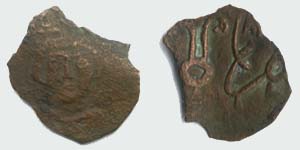
ES 30. Unknown Ishkhid. Obverse: Image of the ruler from the front. Reverse: Tamga sign, to the right of it is a Sogdian legend. (# 41 O.I. Smirnova, Union catalog…, # 1360). Bronze.
14 x 12 mm.
/Extremely Rare/
Samitan
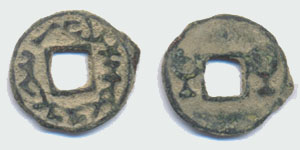
ES 31. Ruler of Samitan. Obverse: Around the square hole is the Sogdian legend.
Reverse: To the right and left of the square hole are tamga signs. (#56 O.I. Smirnova, Numismatic notes.). /Rare/
Unknown ruler
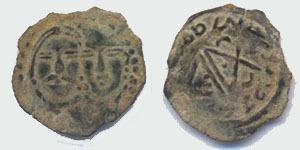
ES 32. Unknown ruler of the 7th-8th centuries. Obverse: Paired image of the ruler and queen. Reverse: In the middle is a monogram, represented by a combination of two runic Signs “ush + th”.
There is an inscription around it in Sogdian script. (# 41 O.I. Smirnova, Union catalogue…, # 1482) /Rare/
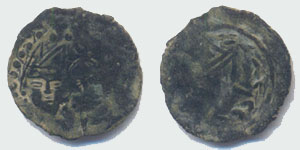
ES 33. Unknown ruler of the 7th-8th centuries. Obverse: Paired image of the ruler and queen. Reverse: In the middle is a monogram, represented by a combination of two runic Signs “ush + th”.
There is an inscription around it in Sogdian script. /Extremely Rare/
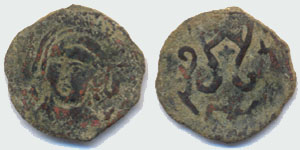
ES 34. Obverse: Bust-length image of a female deity in a hemispherical headdress.
There is a decoration with large beads on the neck, large earrings in the ears. Reverse: In the center there is a lyre-shaped tamga sign, around is a Sogdian legend. ( # 41 O.I. Smirnova, Union catalogue…, # 1477 ). Bronze. /Extremely Rare/
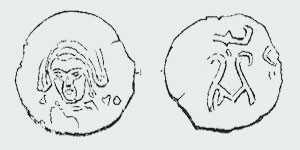
ES 35. Obverse: Bust-length image of a female deity in a hemispherical headdress. Reverse: In the center there is a lyre-shaped tamga sign, around is a Sogdian legend. ( # 41 O.I. Smirnova, Union catalogue…, # 1478 ). Bronze. /Extremely Rare/
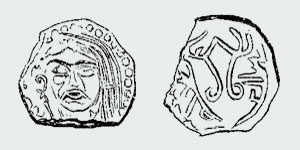
ES 36. Unknown ruler.
VII – VIII century. Obverse: Image of the deity’s head in front.
To the left of the portrait is a Sogdian legend written in semi-cursive writing. Reverse: Tamga sign.
To the right and left of it is a Sogdian legend. Bronze. ( # 41 O.I. Smirnova, Union catalogue…, # 1481 ). /Extremely Rare/
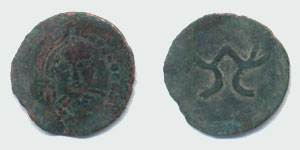
ES 40.
Unknown ruler.
VI-VII centuries Obverse: The head of the ruler is turned three-quarters to the right. Reverse: In the center of the coin there is a tamga sign (around a Sogdian legend) Bronze. Unpublished. /Extremely Rare/
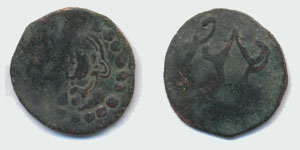
ES 41.
Unknown ruler.
VI-VII centuries Obverse: The head of the ruler is turned three-quarters to the left. Reverse: In the center of the coin there is a tamga sign, around is a Sogdian legend. Bronze. Unpublished. /Extremely Rare/
Ramchitak
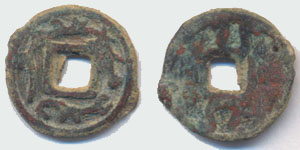
ES 37.
Ruler Ramchitak.
VII-VIII century. Obverse: Sogdian legend around a square hole. Reverse: Above and below the square hole there is a tamga sign. Bronze. ( # 41 O.I. Smirnova, Union catalogue…, # 1392 ). /Rare/
Southern Sogd
Imitation of the drachma of Alexander the Great

SS 1. Imitation of the drachma of Alexander the Great.
II-I century
BC. Obverse: Head of a ruler in a helmet to the right. Reverse: Image of a seated Zeus with a bird on his outstretched arm.
The throne and the staff are represented by convex dots. (#19 Zeimal E.V. Ancient coins of Tajikistan. table #9 #04.) Silver.
D-17 mm.
Weight 2.2 grams.
/ Extremely Rare /
Fseigaharis

SS 2. Ruler Fseigaharis.
I century BC. – I century
AD Obverse: Head of the ruler to the right wearing a headdress in the form of a flat cap. Reverse: Image of standing Hercules.
On the right and left is a legend in Greek letters: FCEIGACARI
C. ( # 36 Rtveladze E.V. Ancient coins of Central Asia. p. 96. #20.) Silver.
D-15 mm.
Weight 1.9 grams.
/ Extremely Rare /
Unknown ruler

SS 3. Unknown ruler.
I-II centuries
AD Obverse: Schematic image of a standing Hercules.
In the right hand is a club, in the left is a ring with long hanging ribbons.
To his left is a one-word Sogdian legend. Reverse: Image of Zeus sitting on a throne.
In the right outstretched hand is a bird (?).
In front of him is a vertically located Sogdian legend from one word. (#36 Rtveladze E.V. Ancient coins of Central Asia. p. 126. #35.) Silver.
D-13 mm.
Weight 0.6 grams.
/Rare/

SS 4. Unknown ruler.
IV-VI centuries AD Obverse: Head of the ruler to the left.
Facing a Sogdian legend. Reverse: Image of a martial arts scene. (#36 Rtveladze E.V. Ancient coins of Central Asia. p. 134. #39.) Copper.
D-16 mm.
Weight 1.9 grams.
/ Scarse /

SS 5. Unknown ruler.
VI-VII centuries Obverse: Image of a horse to the right.
On three sides of it there is a Sogdian legend. Reverse: Tamga sign, above it is a Sogdian legend. ( # 41 O.I. Smirnova, Union catalogue…, # 1450 ). Bronze.
D-20 mm.
Weight 2.3 grams.
/ Scarse /

SS 6. Unknown ruler.
VI-VII centuries Obverse: Image of a horse to the right.
On three sides of it there is a Sogdian legend. Reverse: Head of a ruler with Mongoloid facial features in front. ( # 41 O.I. Smirnova, Union catalogue…, # 1452 ). Bronze.
D-19 mm.
Weight 1.8 grams.
/ Scarse /

SS 7. Unknown ruler.
VI-VII centuries Obverse: Image of a horse to the right.
On three sides of it there is a Sogdian legend. Reverse: Smooth, no differences. ( # 41 O.I. Smirnova, Union catalogue…, # 1457 ). Bronze.
/ Scarse /
Akhurpat

SS 8. Ruler Akhurpat.
VII century Obverse: Head of a ruler in a winged crown to the right.
In front of the Sogdian legend “Grace”. Reverse: In the middle field, a Sogdian inscription consisting of one word “Baga” is enclosed in a square frame.
Around the frame is the Sogdian legend “Ragfan Akhurpat (?)”.
On the left is an image of a triskeles. ( # 41 O.I. Smirnova, Union catalogue…, # 1356 ). Bronze.
D-18 mm.
Weight 1.5 grams.
/ Extremely Rare /

SS 9. Ruler Akhurpat.
VII century Obverse: Head of a ruler wearing a crown to the right.
Facing a Sogdian legend. Reverse: Image of a triskeles enclosed in a triangular frame.
There is a Sogdian legend around. Bronze.
D-17 mm.
Weight 1.4 grams.
/ Extremely Rare /
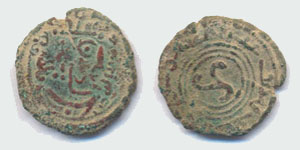
SS 12. Ruler Akhurpat.
VII century Obverse: Head of a ruler wearing a crown to the right.
Facing a Sogdian legend. Reverse: Image of a triskeles.
There is a Sogdian legend around. Bronze.
/ Extremely Rare /
Unknown ruler

SS 10. Unknown ruler.
VIII century. Obverse: Image of a horse to the left, above it a Sogdian legend from one word. Reverse: Circular legend in Arabic script “Muhammad the Messenger of Allah.” ( # 41 O.I. Smirnova, Union catalogue…, # 1667 ). Bronze.
D-19 mm.
Weight 1.9 grams.
/ Very Rare /
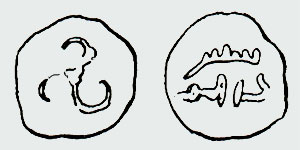
SS 11. Unknown ruler.
VIII century. Obverse: Image of a triskeles. Reverse: In the field there is a two-line inscription in early Kufic script: “Sixty in a dirham.” ( # 41 O.I. Smirnova, Union catalogue…, # 1676 ). Bronze.
/ Very Rare /
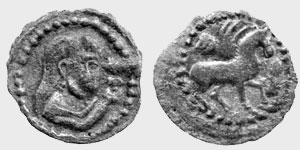
SS 13.
Unknown ruler.
VI-VII centuries Obverse: Image of a deity or ruler, three-quarters to the right. Reverse: Image of a winged horse to the right. Bronze. / Extremely Rare /
Bukharkhudaty
Sasanian king Varahran V
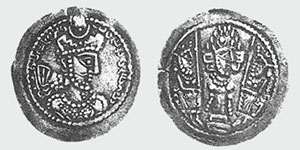
Bk 1. Drachma of the Sasanian king Varahran V (421-438) Obverse: Bust image of the king to the right.
In front of and behind the head is a Pahlavi legend. Reverse: In the center of the coin is an altar with the head of Ahura Mazda surrounded by flames.
On both sides of the altar there are figures of mobeds. The drachma of the Sasanian king Varahran V was the prototype for imitative issues in Central Asia. (#53 E. Zeimal’, Circulation…, p.248, #1.) Silver.
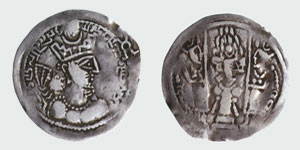
Bk 2. Drachma of the Sasanian king Varahran V (421-438) Obverse: Bust image of the king to the right.
In front of and behind the head is a Pahlavi legend.
In the field of the coin there is a countermark – Bukhara tamga. Reverse: In the center of the coin is an altar with the head of Ahura Mazda surrounded by flames.
On both sides of the altar there are figures of mobeds. (#53 E. Zeimal’, Circulation…, p.248, #2.) Silver.
D-29 mm.
Weight 3.9 grams.
/ Extremely Rare /
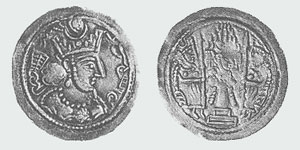
Bk 3. Imitation of the drachma of the Sasanian king Varahran V. V-early VI century. Obverse: Bust of the king to the right, in front of the face and behind the head, a distorted Pahlavi legend. Reverse: In the center of the coin is an altar with the head of Ahura Mazda surrounded by flames.
On both sides of the altar there are figures of mobeds. (#53 E. Zeimal’, Circulation…, p.248, #3.) Silver.
/ Extremely Rare /
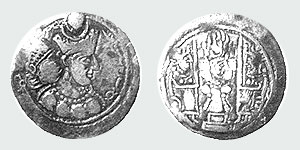
Bk 4. Imitation of the drachma of the Sasanian king Varahran V. V-early VI century. Obverse: Bust of the king to the right, in front of the face and behind the head, a distorted Pahlavi legend.
Behind the head, on the rim, there is a countermark – Bukhara tamga. Reverse: In the center of the coin is an altar with the head of Ahura Mazda surrounded by flames.
On both sides of the altar there are figures of mobeds. (#53 E. Zeimal’, Circulation…, p.248, #4.) Silver.
/ Extremely Rare /
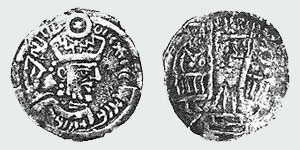
Bk 5. Imitation of the drachma of the Sasanian king Varahran V. Second half of the 7th – first quarter of the 8th century. Obverse: Bust of the ruler wearing a crown to the right.
Above the crown is a circle with a dot in the middle.
In front of the face is a Sogdian legend, beginning under the portrait.
Behind the head is a distorted Pahlavi legend. Reverse: In the center of the coin there is an altar with the head of Ahura Mazda to the right.
On both sides of the altar there are figures of mobeds. (#53 E. Zeimal’, Circulation…, p.248, #7.) Silver.
/ Extremely Rare /
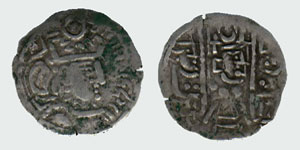
Bk 6. Imitation of the drachma of the Sasanian king Varahran V. Second half of the 7th – first quarter of the 8th century. Obverse: Bust of the ruler wearing a crown to the right.
Above the crown is a circle with a dot in the middle.
In front of the face is the Sogdian legend – “King of Bukhara”, behind the head is a distorted Pahlavi legend. Reverse: In the center of the coin there is an altar with the head of Ahura Mazda to the right.
On both sides of the altar there are figures of mobeds. The image on coins of this type (Bk6-Bk10) is crude and schematic.
The coin circle is thin and has slight skiffiness.
And apparently due to the technical features of the minting, the coins have a significant number of cracks. ( # 42 O.I. Smirnova, Catalog of coins…, # 3.) Silver.
D-29.5 mm.
Weight 3.1 grams.
/ Very Rare /
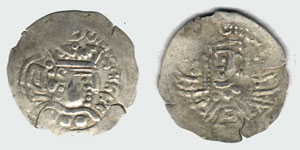
Bk 7. Imitation of the drachma of the Sasanian king Varahran V. Second half of the 7th – first quarter of the 8th century. Obverse: Bust of the ruler wearing a crown to the right.
Above the crown is a circle with a dot in the middle.
In front of the face is the Sogdian legend – “King of Bukhara”, behind the head is a distorted Pahlavi legend. Reverse: In the center of the coin there is an altar with the head of Ahura Mazda to the left.
On both sides of the altar there are figures of mobeds. Silver.
D-32.5 mm.
Weight 2.8 grams.
/ Very Rare /
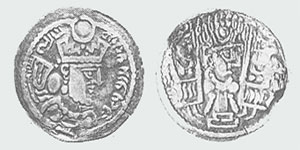
Bk 8. Imitation of the drachma of the Sasanian king Varahran V. VI century. Obverse: Bust of the king to the right.
In front of the face is a Sogdian inscription, behind the head is a distorted Pahlavi legend. Reverse: In the center of the coin is an altar with the head of Ahura Mazda surrounded by flames.
On both sides of the altar there are figures of mobeds. Silver.
/ Extremely Rare /
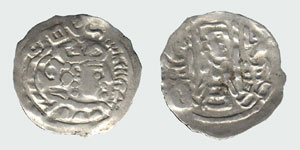
Bk 9. Imitation of the drachma of the Sasanian king Varahran V. Second half of the 7th – first quarter of the 8th century. Obverse: Bust of the ruler wearing a crown to the right.
Above the crown is a circle with a dot in the middle.
In front of the face is the Sogdian legend – “King of Bukhara”, behind the head is a distorted Pahlavi legend.
There is a mark above the head. Reverse: In the center of the coin there is an altar with the head of Ahura Mazda to the right.
On both sides of the altar there are figures of mobeds. Silver.
D-30 mm.
Weight 2.6 grams.
/ Extremely Rare /
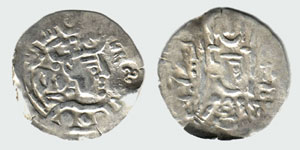
Bk 10. Imitation of the drachma of the Sasanian king Varahran V. Second half of the 7th – first quarter of the 8th century. Obverse: Bust of the ruler wearing a crown to the right.
Above the crown is a circle with a dot in the middle.
In front of the face is the Sogdian legend – “King of Bukhara”, behind the head is a distorted Pahlavi legend.
A triskeles mark is placed in front of the face. Reverse: In the center of the coin there is an altar with the head of Ahura Mazda to the right.
On both sides of the altar there are figures of mobeds. (#10 Antiquities of Tajikistan, #635.) Silver.
D-33 mm.
Weight 2.9 grams.
/ Extremely Rare /

Bk 11. Imitation of the drachma of the Sasanian king Varahran V. Second half of the 7th – first quarter of the 8th century. Obverse: Bust of the ruler wearing a crown to the right.
Above the crown is a circle with a dot in the middle.
In front of the face of the Sogdian legend – “King of Bukhara”.
There is a mark behind the head. Reverse: In the center of the coin there is an altar with the head of Ahura Mazda to the right.
On both sides of the altar there are figures of mobeds. Silver.
D-33 mm.
Weight 3.3 grams.
/ Extremely Rare /
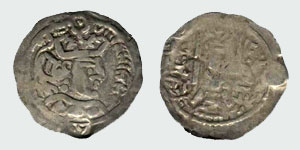
Bk 12. Imitation of the drachma of the Sasanian king Varahran V. Second half of the 7th – first quarter of the 8th century. Obverse: Bust of the ruler wearing a crown to the right.
Above the crown is a circle with a dot in the middle.
In front of the face of the Sogdian legend – “King of Bukhara”.
There is a countermark under the portrait. Reverse: In the center of the coin there is an altar with the head of Ahura Mazda to the right.
On both sides of the altar there are figures of mobeds. Silver.
/ Extremely Rare /
Turgar
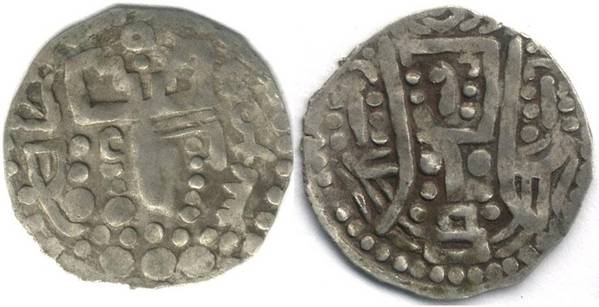
Bk 13. Ruler Turgar.
40s of the 8th century. Obverse: Head of the ruler to the right, circle above the crown.
In front of the ruler’s face is the Sogdian inscription “Turgar”.
Behind the head is a distorted Pahlavi legend. Reverse: In the center of the coin there is a fire altar with the head of Ahura Mazda to the left, enclosed in a rectangular frame.
On both sides of the altar there are figures of mobeds. ( # 42 O.I. Smirnova, Catalog of coins…, # 12 ). Silver.
D-26 mm.
Weight 3.3 grams.
/ Extremely Rare /
Unknown ruler
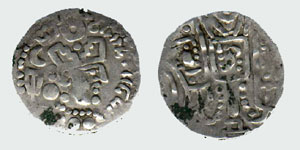
Bk 14. Unknown ruler.
First quarter of the 8th century. Obverse: Bust of the ruler wearing a crown to the right, a circle above the crown.
In front of the face there is a Sogdian inscription – “King of Bukhara”, behind the head there is a distorted Pahlavi legend. Reverse: In the center of the coin is an altar with the head of Ahura Mazda to the left, and is enclosed in a rectangular frame.
On both sides of the altar there are figures of mobeds. Silver.
D-26 mm.
Weight 3.1 grams.
/ Very Rare /
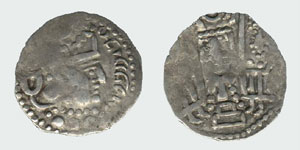
Bk 15. Unknown ruler.
First quarter of the 8th century. Obverse: Bust of the ruler wearing a crown to the right, a circle above the crown.
In front of the face there is a Sogdian inscription – “King of Bukhara”, behind the head there is a distorted Pahlavi legend. Reverse: In the center of the coin there is an altar with the head of Ahura Mazda to the right, and is enclosed in a rectangular frame.
On both sides of the altar there are figures of mobeds. Silver.
D-25.5 mm.
Weight 2.8 grams.
/ Very Rare /
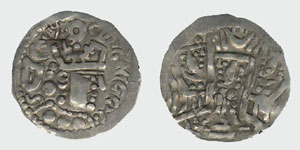
Bk 16. Unknown ruler.
First half of the 8th century. Obverse: Bust of the ruler wearing a crown to the right, a circle above the crown.
In front of the face there is a Sogdian inscription – “King of Bukhara”.
Behind the head is a distorted Pahlavi legend.
The coin bears an oval countermark containing a legend of two, possibly Sogdian letters. Reverse: In the center of the coin is an altar with the head of Ahura Mazda to the left, and is enclosed in a rectangular frame.
On both sides of the altar there are figures of mobeds. Silver.
D-25 mm.
Weight 2.9 grams.
/ Extremely Rare /
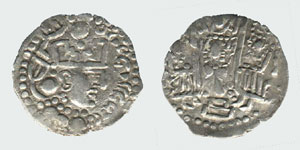
Bk 17. Unknown ruler.
First quarter of the 8th century. Obverse: Bust of the ruler wearing a crown to the right, a circle above the crown.
In front of the face there is a Sogdian inscription – “King of Bukhara”, behind the head there is a distorted Pahlavi legend. Reverse: In the center of the coin is an altar with the head of Ahura Mazda facing right, surrounded by a thin border.
On both sides of the altar there are figures of mobeds. Silver.
D-24.5 mm.
Weight 2.7 grams.
/ Very Rare /
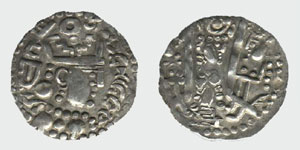
Bk 18. Unknown ruler.
First quarter of the 8th century. Obverse: Bust of the ruler wearing a crown to the right, a circle above the crown.
In front of the face there is a Sogdian inscription – “King of Bukhara”, behind the head there is a distorted Pahlavi legend. Reverse: In the center of the coin there is an altar with the head of Ahura Mazda to the right.
On both sides of the altar there are figures of mobeds. Silver.
D-25 mm.
Weight 2.4 grams.
/ Very Rare /
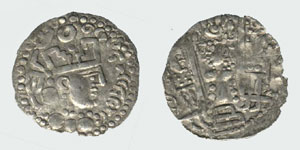
Bk 19. Unknown ruler.
First quarter of the 8th century. Obverse: Bust of the ruler wearing a crown to the right, a circle above the crown.
In front of the face there is a Sogdian inscription – “King of Bukhara”, behind the head there is a distorted Pahlavi legend. Reverse: In the center of the coin there is an altar with the head of Ahura Mazda to the left.
On both sides of the altar there are figures of mobeds. Silver.
D-25 mm.
Weight 2.6 grams.
/ Very Rare /
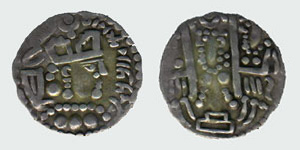
Bk 20. Unknown ruler.
Mid-8th century. Obverse: Bust of the ruler wearing a crown to the right, above the crown there is a crescent with a dot.
In front of the face there is a Sogdian inscription – “King of Bukhara”, behind the head there is a distorted Pahlavi legend. Reverse: In the center of the coin there is an altar with the head of Ahura Mazda to the left.
On both sides of the altar there are figures of mobeds. Silver.
D-24.5 mm.
Weight 2.9 grams.
/ Very Rare /
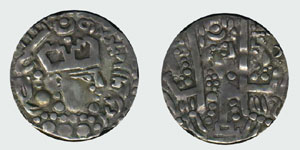
Bk 21. Unknown ruler.
Mid-8th century. Obverse: Bust of the ruler wearing a crown to the right, above the crown there is a crescent with a dot.
In front of the face there is a Sogdian inscription – “King of Bukhara”, behind the head there is a distorted Pahlavi legend. Reverse: In the center of the coin there is an altar with the head of Ahura Mazda to the right.
On both sides of the altar there are figures of mobeds. ( # 42 O.I. Smirnova, Catalog of coins…, # 13 ). Silver.
D-25 mm.
Weight 2.6 grams.
/ Scarce /
Khalid
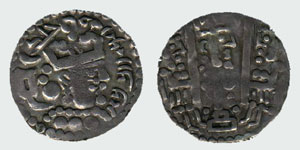
Bk 22. Ruler Khalid.
750-752 Obverse: Bust of the ruler wearing a crown to the right, a circle above the crown.
In front of the face is the Sogdian legend – “King of Bukhara”, behind the head is the Arabic inscription “Khalid”. Reverse: In the center of the coin there is an altar with the head of Ahura Mazda to the right.
On both sides of the altar there are figures of mobeds. (#10 Antiquities of Tajikistan, #639.) Silver.
D-25 mm.
Weight 2.9 grams.
/ Very Rare /
Muhamad
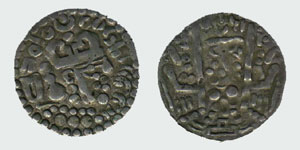
Bk 23. Ruler Muhamad.
Third quarter of the 8th century. Obverse: Bust of the ruler wearing a crown to the right, above the crown there is a crescent with a dot.
In front of the face is the Sogdian legend – “King of Bukhara”, behind the head is the Arabic inscription “Mukhamad”. Reverse: In the center of the coin there is an altar with the head of Ahura Mazda to the right.
On both sides of the altar there are figures of mobeds. Silver.
D-24.5 mm.
Weight 2.7 grams.
/Rare/
Harun al-Rashid
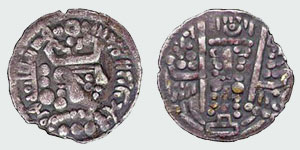
Bk 25. Ruler Harun.
Third quarter of the 8th century. Obverse: Bust of the ruler wearing a crown to the right.
In front of the face is the Sogdian legend – “The King of Bukhara”, behind the head is a lengthy Arabic legend. Reverse: In the center of the coin there is an altar with the head of Ahura Mazda to the right.
On both sides of the altar there are figures of mobeds. Silver.
/ Extremely Rare /
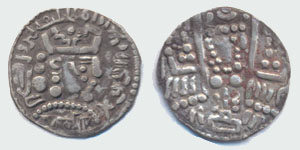
Bk 30. Ruler Harun al-Rashid and Ja’far b.
Muhammad.
787-789 Obverse: Bust of the ruler wearing a crown to the right.
In front of the face is the Sogdian legend – “King of Bukhara”, behind the head is the Arab legend Caliph Harun, under the portrait of Jafar. Reverse: In the center of the coin there is an altar with the head of Ahura Mazda to the right.
On both sides of the altar there are figures of mobeds. Silver.
/ Extremely Rare /
Abbasid imitation of Bukhara drachmas
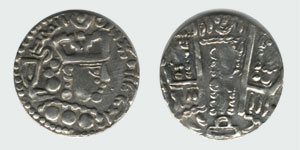
Bk 26. Abbasid imitation of Bukhara drachmas.
With the name of the governor Abbasid al-Mahdi.
(third quarter of the 8th century.) Obverse: Bust of a ruler wearing a crown to the right, above the crown a crescent with a dot.
In front of the face is the Sogdian legend – “King of Bukhara”, behind the head is the Arabic inscription “al-Mahdi”. Reverse: In the center of the coin there is an altar with the head of Ahura Mazda to the right.
On both sides of the altar there are figures of mobeds. Silver.
D-25 mm.
Weight 2.7 grams.
/ Scarce /
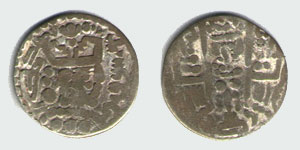
Bk 27. Abbasid imitation of Bukhara drachmas.
With the name of the governor Abbasid al-Mahdi.
(third quarter of the 8th – 10th centuries) Obverse: Bust of a ruler wearing a crown to the right, above the crown a crescent with a dot.
In front of the face is the Sogdian legend – “King of Bukhara”, behind the head is the Arabic inscription “al-Mahdi”. Reverse: In the center of the coin there is an altar with the head of Ahura Mazda to the right.
On both sides of the altar there are figures of mobeds. Bilon.
D-25 mm.
Weight 2.2 grams.
/Common/
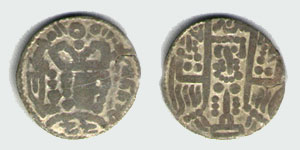
Bk 28. Abbasid imitation of Bukhara drachmas.
With the name of the governor Abbasid al-Mahdi.
(third quarter of the 8th – 10th centuries) Obverse: Bust of a ruler wearing a crown to the right, above the crown a crescent with a dot.
In front of the face is the Sogdian legend – “King of Bukhara”, behind the head is the Arabic inscription “al-Mahdi”.
There are two signs under the portrait, instead of three dots. Reverse: In the center of the coin there is an altar with the head of Ahura Mazda to the right.
On both sides of the altar there are figures of mobeds. Bilon.
D-24 mm.
Weight 2.2 grams.
/ Scarce /
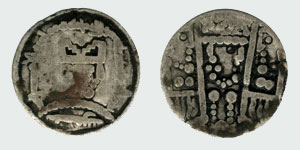
Bk 29. Imitation of Bukhara drachmas.
With the name of Caliph al-Amin (809 – 814) Obverse: Bust of the ruler wearing a crown to the right, a dot above the crown.
There is an Arabic legend around. Reverse: In the center of the coin there is an altar with the head of Ahura Mazda to the right.
On both sides of the altar there are figures of mobeds. Bilon.
D-25 mm.
Weight 2.1 grams.
/ Scarce /
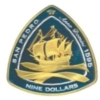





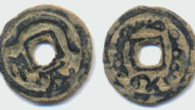
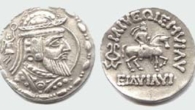
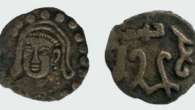
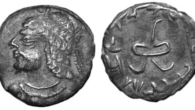
Leave a Reply